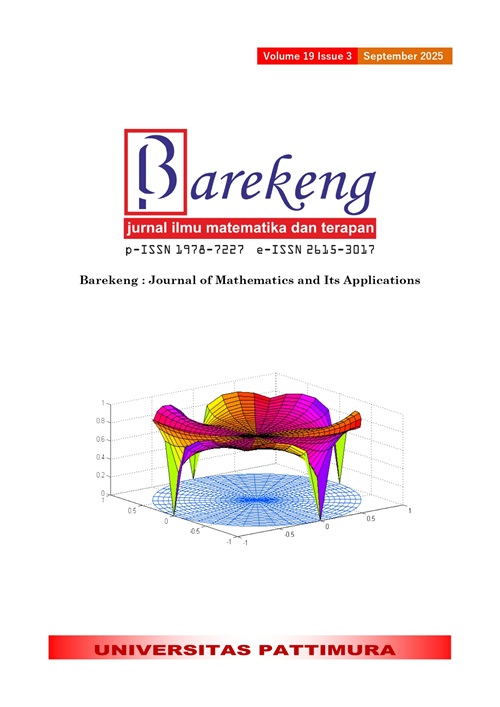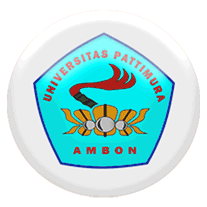MATHEMATICAL MODEL OF DENGUE HEMORRHAGIC FEVER SPREAD WITH DIFFERENT LEVELS OF TRANSMISSION RISK
Abstract
Dengue Haemorrhagic Fever (DHF) is a vector-borne disease caused by the dengue virus, transmitted to humans through the bite of an infected female Aedes aegypti mosquito. DHF is prevalent in tropical regions, necessitating mathematical modeling to better understand its dynamics and predict its spread. This study develops and analyzes a mathematical model for DHF transmission that incorporates seven compartments to reflect different transmission risk levels. Stability analysis of the disease-free and endemic equilibria was conducted, with the basic reproduction number used to classify the conditions under which DHF transmission is controlled or endemic . Key model parameters were estimated using DHF case data from East Java in 2018, employing a genetic algorithm (GA) to optimize the estimation process. The GA approach achieved a mean absolute percentage error (MAPE) of , ensuring high accuracy in parameter values. Furthermore, the basic reproduction number was determined to be , which is greater than one, confirming that DHF remains endemic in East Java. Sensitivity analysis identified the mosquito biting rate , mosquito mortality rate , and transmission rates as the most critical factors influencing . Numerical simulations demonstrated the effects of these key parameters on both and the symptomatic human population . An increase in , , or significantly amplified and , while a rise in had the opposite effect, reducing both transmission and infections. These results underscore the critical role of vector control strategies, such as increasing mosquito mortality and reducing breeding sites, in mitigating DHF outbreaks. This study highlights the utility of combining mathematical modeling with genetic algorithm-based parameter estimation to provide accurate insights into disease dynamics and inform effective control measures.
Downloads
References
World Health Organization, “DENGUE GUIDELINES, FOR DIAGNOSIS, TREATMENT, PREVENTION AND CONTROL.” Accessed: Sep. 19, 2020. [Online]. Available: https://www.who.int/publications/i/item/9789241547871
D. J. Gubler, “DENGUE AND DENGUE HEMORRHAGIC FEVER,” Clin. Microbiol. Rev., vol. 11, no. 3, pp. 480–496, 1998, https://doi.org/10.1016/B978-0-443-06668-9.50077-6.
A. Wilder-Smith, E. E. Ooi, S. G. Vasudevan, and D. J. Gubler, “UPDATE ON DENGUE: EPIDEMIOLOGY, VIRUS EVOLUTION, ANTIVIRAL DRUGS, AND VACCINE DEVELOPMENT,” Curr. Infect. Dis. Rep., vol. 12, no. 3, pp. 157–164, 2010, https://doi.org/10.1007/s11908-010-0102-7.
World Health Organization, “GLOBAL STRATEGY FOR DENGUE PREVENTION AND CONTROL, 2012–2020.” Accessed: Sep. 19, 2020. [Online]. Available: https://www.who.int/publications/i/item/9789241504034
Health Department of East Java Province Indonesia, “PROFIL KESEHATAN PROVINSI JAWA TIMUR TAHUN 2018,” DINAS KESEHATAN PROVINSI JAWA TIMUR. Accessed: Sep. 19, 2020. [Online]. Available: https://dinkes.jatimprov.go.id/index.php?r=site/file_list&id_file=10&id_berita=8
Ministry of Health of the Republic Indonesia, “PROFIL KESEHATAN INDONESIA TAHUN 2017.” Accessed: Sep. 19, 2020. [Online]. Available: https://www.kemkes.go.id/id/profil-kesehatan-indonesia-2017
E. Bonyah, M. L. Juga, C. W. Chukwu, and Fatmawati, “A FRACTIONAL ORDER DENGUE FEVER MODEL IN THE CONTEXT OF PROTECTED TRAVELERS,” Alexandria Eng. J., vol. 61, no. 1, pp. 927–936, 2022, https://doi.org/10.1016/j.aej.2021.04.070.
D. Handayani, A. U. Gunadi, and R. N. Rachmawati, “MATHEMATICAL MODEL OF REPELLENT EFFECT IN DENGUE TRANSMISSION,” BAREKENG J. Math. Its Appl., vol. 18, no. 2, pp. 1037–1052, May 2024, https://doi.org/10.30598/barekengvol18iss2pp1037-1052.
T. P. Blante, J. Jaharuddin, and E. H. Nugrahani, “SENSITIVITY ANALYSIS OF SI1I2RS MODEL FOR DENGUE FEVER TRANSMISSION,” Jambura J. Biomath., vol. 5, no. 1, pp. 19–26, 2024, https://doi.org/10.37905/jjbm.v5i1.23132.
A. Abidemi, Fatmawati, and O. J. Peter, “AN OPTIMAL CONTROL MODEL FOR DENGUE DYNAMICS WITH ASYMPTOMATIC, ISOLATION, AND VIGILANT COMPARTMENTS,” Decis. Anal. J., vol. 10, no. June 2023, p. 100413, 2024, https://doi.org/10.1016/j.dajour.2024.100413.
F. B. Agusto and M. A. Khan, “OPTIMAL CONTROL STRATEGIES FOR DENGUE TRANSMISSION IN PAKISTAN,” Math. Biosci., vol. 305, no. July, pp. 102–121, 2018, https://doi.org/10.1016/j.mbs.2018.09.007.
R. Jan, M. A. Khan, P. Kumam, and P. Thounthong, “MODELING THE TRANSMISSION OF DENGUE INFECTION THROUGH FRACTIONAL DERIVATIVES,” Chaos, Solitons and Fractals, vol. 127, pp. 189–216, 2019, https://doi.org/10.1016/j.chaos.2019.07.002.
I. Ghosh, P. K. Tiwari, and J. Chattopadhyay, “EFFECT OF ACTIVE CASE FINDING ON DENGUE CONTROL: IMPLICATIONS FROM A MATHEMATICAL MODEL,” J. Theor. Biol., vol. 464, pp. 50–62, 2019, https://doi.org/10.1016/j.jtbi.2018.12.027.
N. Anggriani, H. Tasman, M. Z. Ndii, A. K. Supriatna, E. Soewono, and E. Siregar, “THE EFFECT OF REINFECTION WITH THE SAME SEROTYPE ON DENGUE TRANSMISSION DYNAMICS,” Appl. Math. Comput., vol. 349, pp. 62–80, 2019, https://doi.org/10.1016/j.amc.2018.12.022.
H. Zhang and R. Lui, “RELEASING WOLBACHIA-INFECTED AEDES AEGYPTI TO PREVENT THE SPREAD OF DENGUE VIRUS: A MATHEMATICAL STUDY,” Infect. Dis. Model., vol. 5, pp. 142–160, 2020, https://doi.org/10.1016/j.idm.2019.12.004.
N. Aldawoodi, “AN APPROACH TO DESIGNING AN UNMANNED HELICOPTER AUTOPILOT USING GENETIC ALGORITHMS AND SIMULATED ANNEALING,” University of South Florida, 2008. [Online]. Available: https://www.proquest.com/openview/416ccc976083ba5055b263f0787304e9/1?pq-origsite=gscholar&cbl=18750
Central Bureau of Statistics East Java Province Indonesia, “ANGKA HARAPAN HIDUP (TAHUN), 2017-2019.” Accessed: Sep. 19, 2020. [Online]. Available: https://jatim.bps.go.id/id/statistics-table/2/MjkjMg==/angka-harapan-hidup.html
Central Bureau of Statistics East Java Province Indonesia, “JUMLAH PENDUDUK MENURUT JENIS KELAMIN DAN KABUPATEN/KOTA PROVINSI JAWA TIMUR (JIWA), 2016-2018.” [Online]. Available: https://jatim.bps.go.id/id/statistics-table/2/Mzc1IzI=/jumlah-penduduk-menurut-jenis-kelamin-dan-kabupaten-kota-provinsi-jawa-timur.html
P. Van Den Driessche and J. Watmough, “REPRODUCTION NUMBERS AND SUB-THRESHOLD ENDEMIC EQUILIBRIA FOR COMPARTMENTAL MODELS OF DISEASE TRANSMISSION,” Math. Biosci., vol. 180, no. 1–2, pp. 29–48, 2002, https://doi.org/10.1016/S0025-5564(02)00108-6.
J. P. LaSalle, THE STABILITY OF DYNAMICAL SYSTEMS. Philadelphia: Society for Industrial and Applied Mathematics, 1976.
N. Chitnis, J. M. Hyman, and J. M. Cushing, “DETERMINING IMPORTANT PARAMETERS IN THE SPREAD OF MALARIA THROUGH THE SENSITIVITY ANALYSIS OF A MATHEMATICAL MODEL,” Bull. Math. Biol., vol. 70, no. 5, pp. 1272–1296, 2008, https://doi.org/10.1007/s11538-008-9299-0.
Copyright (c) 2025 Faishal Farrel Herdicho, Nabil Azizul Hakim, Fatmawati Fatmawati, Cicik Alfiniyah, John Olajide Akanni

This work is licensed under a Creative Commons Attribution-ShareAlike 4.0 International License.
Authors who publish with this Journal agree to the following terms:
- Author retain copyright and grant the journal right of first publication with the work simultaneously licensed under a creative commons attribution license that allow others to share the work within an acknowledgement of the work’s authorship and initial publication of this journal.
- Authors are able to enter into separate, additional contractual arrangement for the non-exclusive distribution of the journal’s published version of the work (e.g. acknowledgement of its initial publication in this journal).
- Authors are permitted and encouraged to post their work online (e.g. in institutional repositories or on their websites) prior to and during the submission process, as it can lead to productive exchanges, as well as earlier and greater citation of published works.






1.gif)



